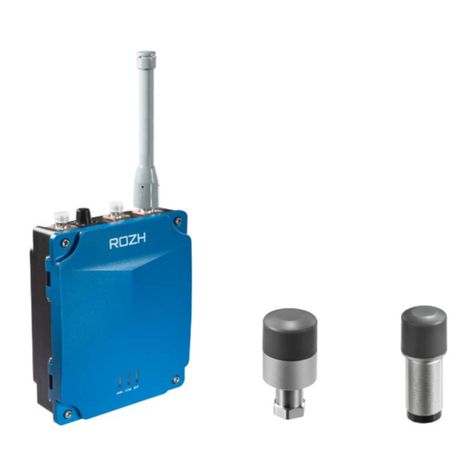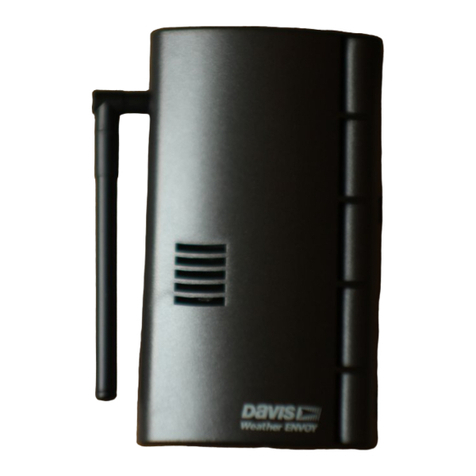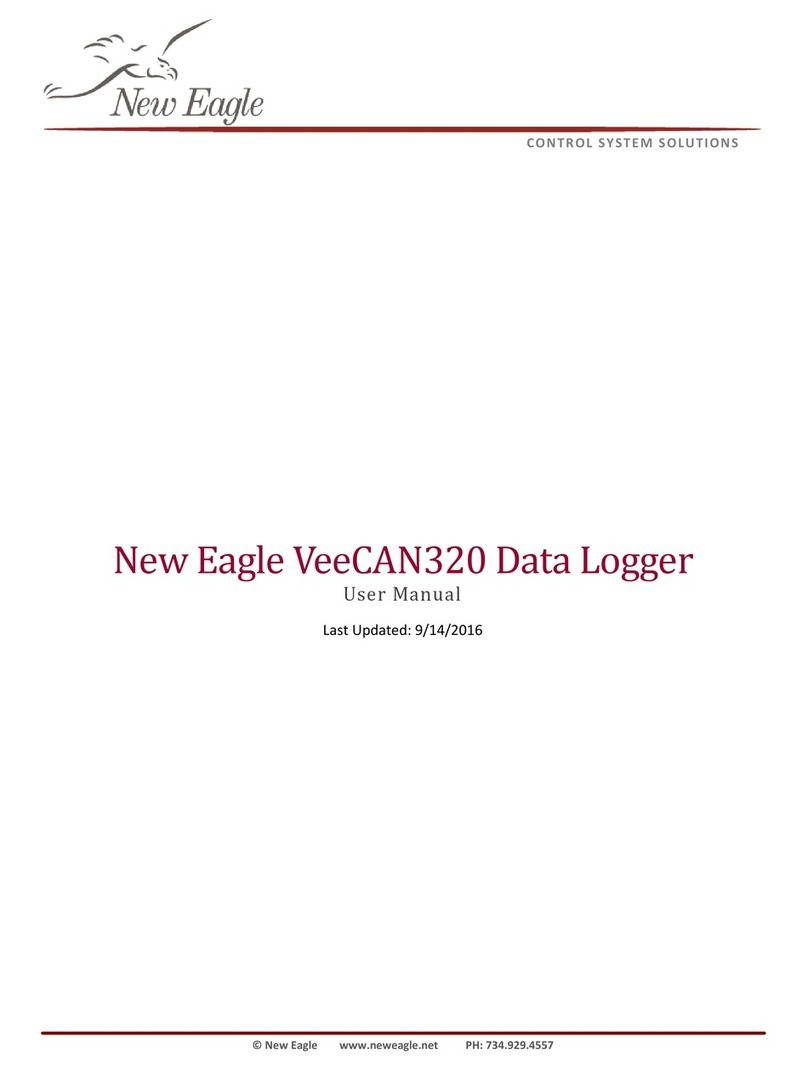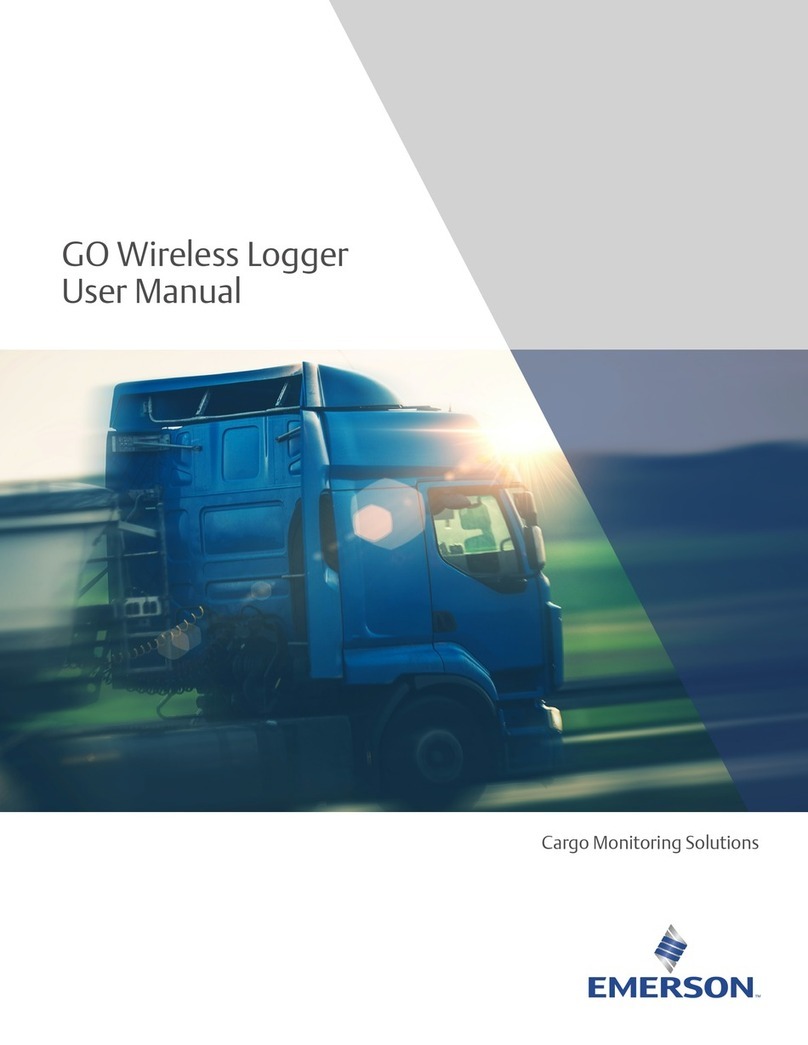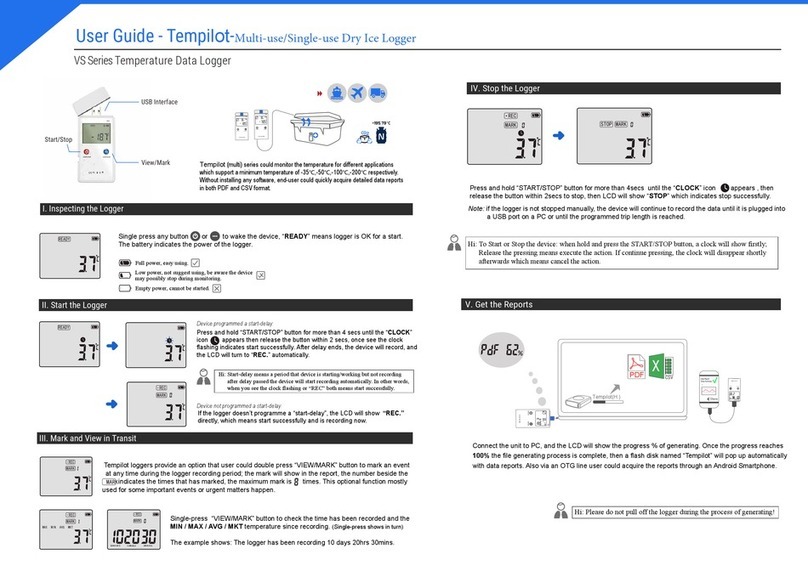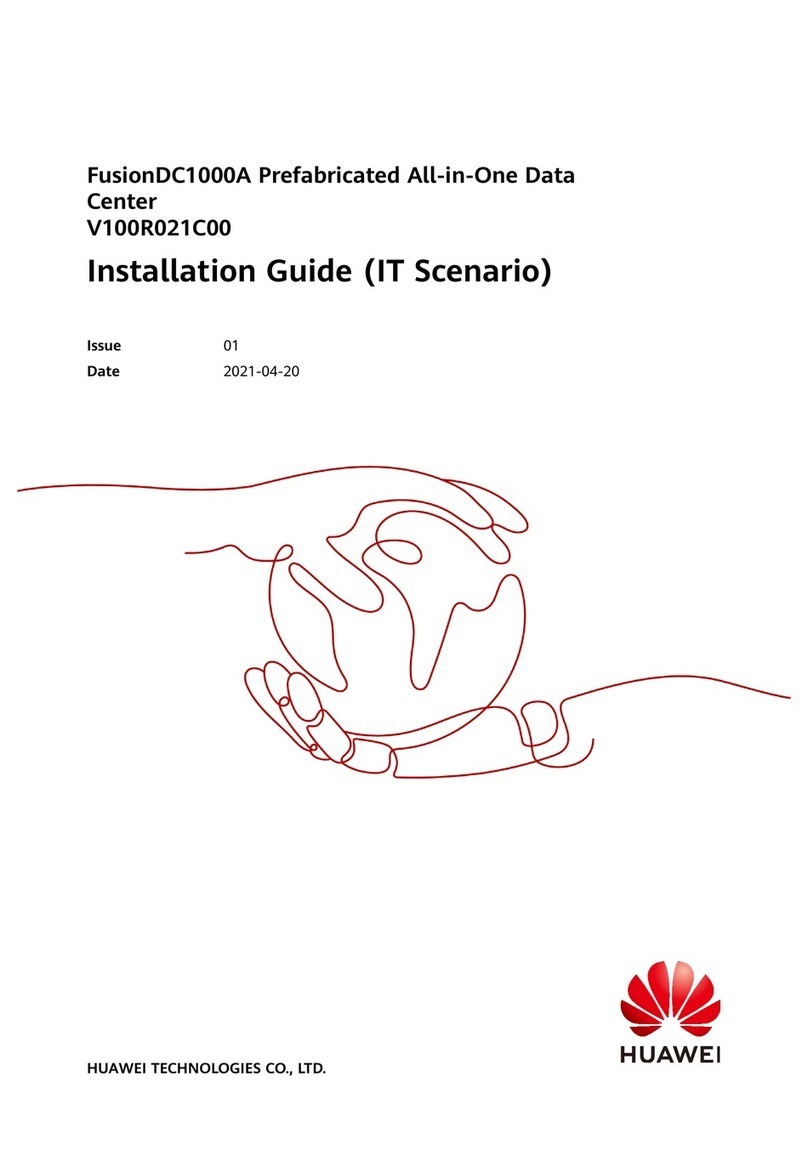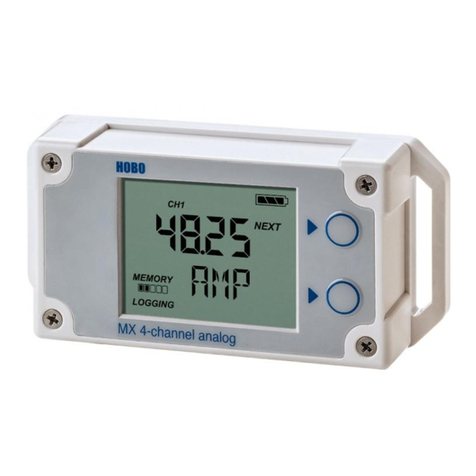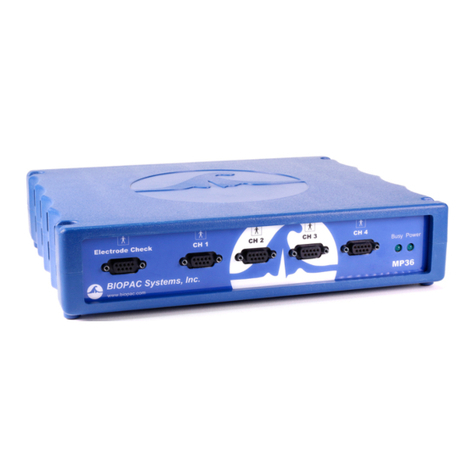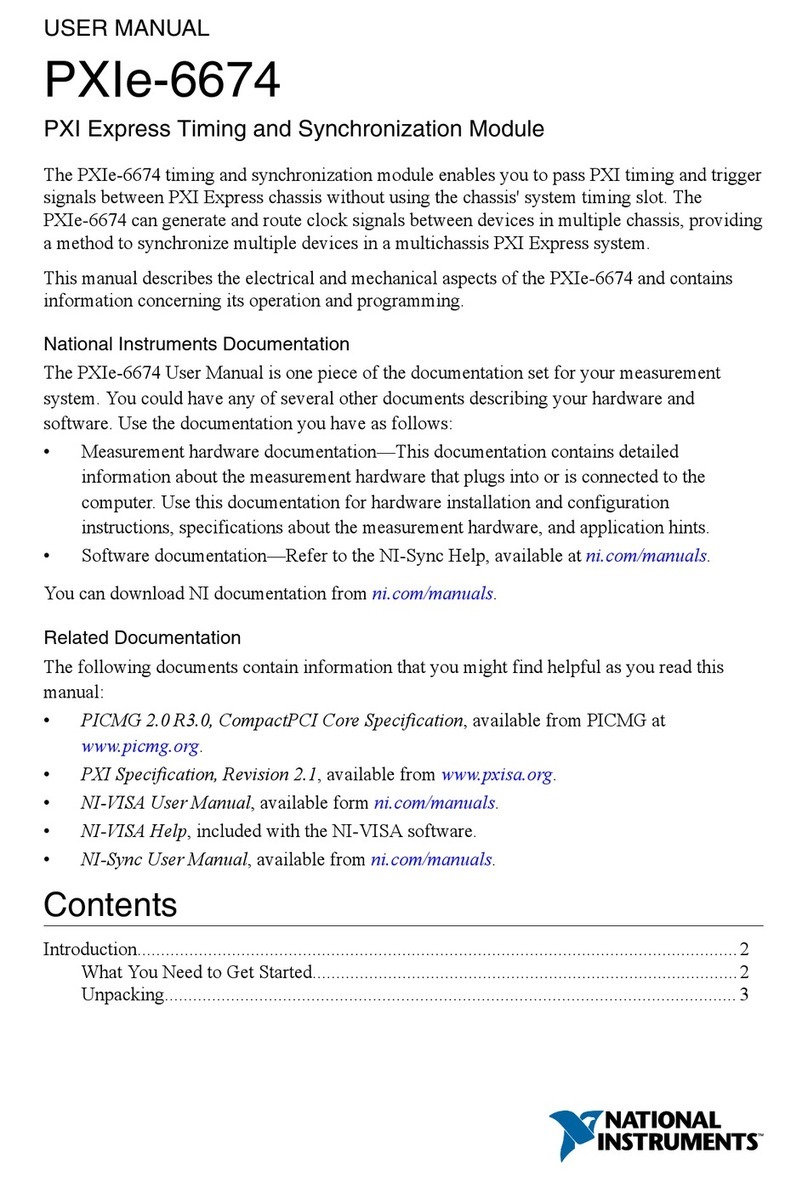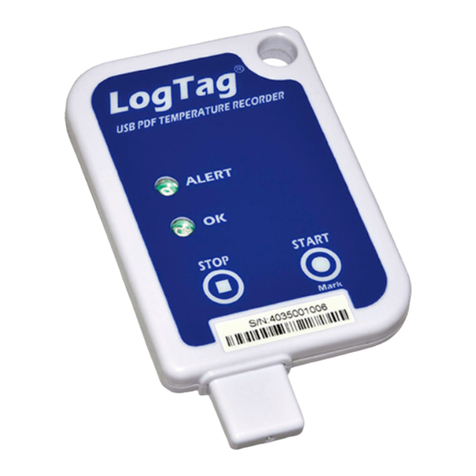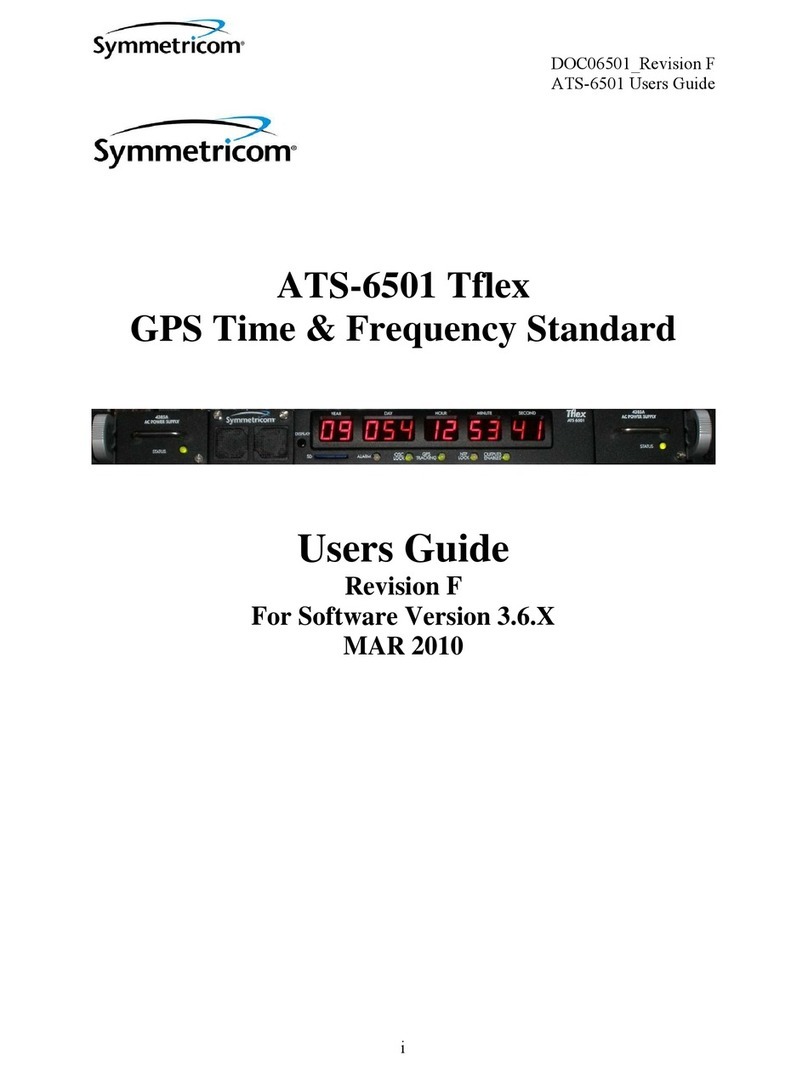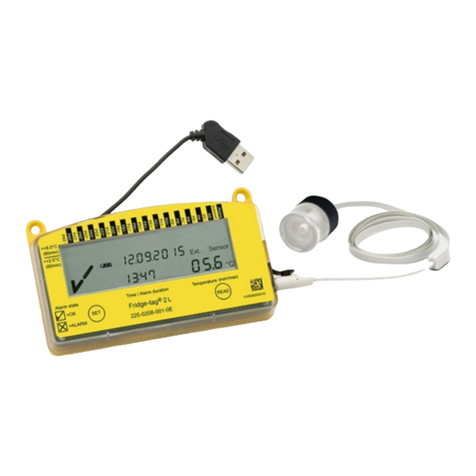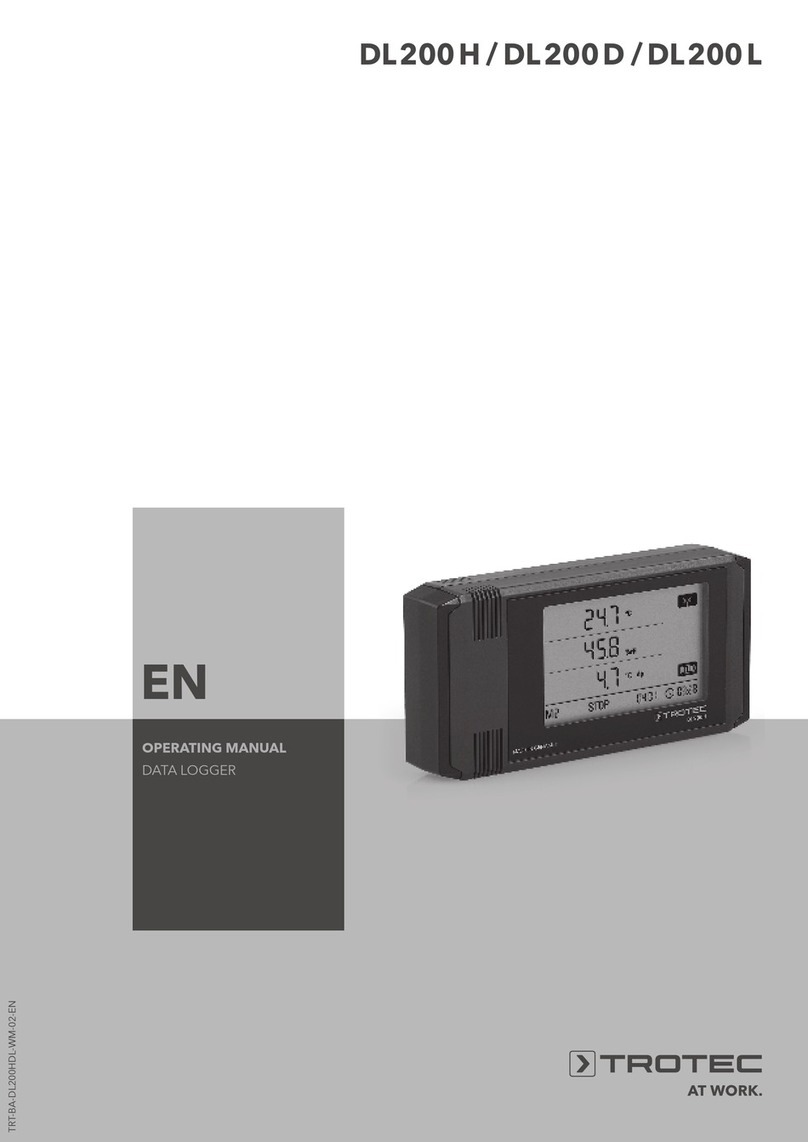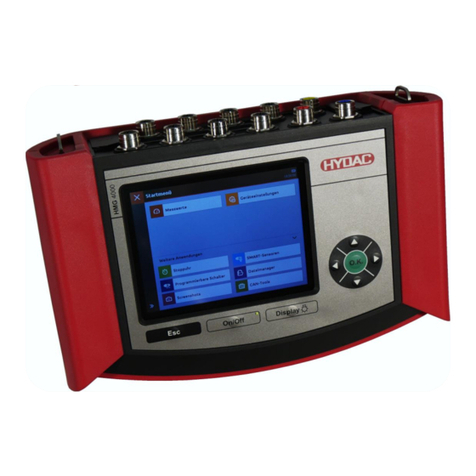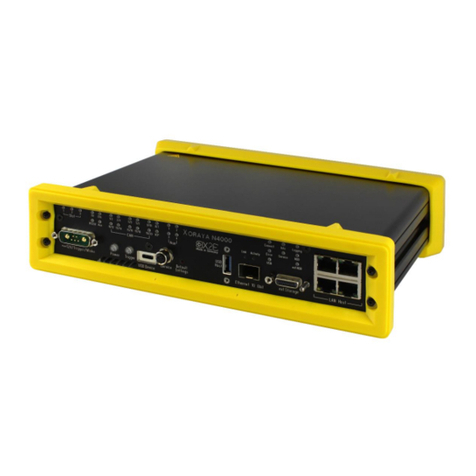Geosense GEOLOGGER G8 PLUS User manual

G8 Plus Manual V1.0
I
N
S
T
R
U
C
T
I
O
N
M
A
N
U
A
L
DATA LOGGER
GEOLOGGER G8 PLUS

G8 Plus Manual V1.0

G8 Plus Manual V1.0
CONTENTS Page
1.0 INTRODUCTION 1
1.1 General Description 1
1.2 Main Components 2
1.3 G8 Module Connections 3
1.4 Electro Magnetic Compatibility (EMC) 4
2.0 CONFORMITY 5
3.0 MARKINGS 6
4.0 DELIVERY 7
4.1 Packaging 7
4.2 Handling 7
4.3 Inspection 7
4.4 Storage 7
5.0 INSTALLATION 8
5.1 Getting Started 8
5.2 Wiring 9
5.2.1 Mains Power with Battery Back Up 10
5.2.2 Battery Power Connection 12
5.2.3 Solar Power Connection 12
5.2.4 Sensor Cable Connection – Braided 13
5.2.5 Sensor Cable Connection – Foil Screened 15
5.2.6 Sensor Cable Connection—Smart Mux 16
5.2.7 Analogue Smart Mux Connection Overview 17
5.3 Modem 18
5.3.1 Modem Antenna Connection 18
5.3.2 Installing SIM Card 19
5.4 Remote Smart Mux 20
6.0OPERATION 21
6.1 Configuration of Peripheral Devices 21
6.2 Wiring of the System 21
6.3 Communications Test 22
6.4 Connecting Sensors 22
6.5 Acquisition and Validity Testing 22
6.6 G8 Functions 22
6.7 Starting the Data Logging Session 22
6.8 G8 Module Navigation 23
6.9 G8 Module Functions 24
6.9.1 Configurations 24
6.9.1.1 G8 Logger Setup 24
6.9.1.1.1 Id Number 24
6.9.1.1.2 Modules Supply 24
6.9.1.1.3 Analogue Inputs 25
6.9.1.1.4 Digital Inputs 26
i

G8 Plus Manual V1.0
ii
Page
6.9 OPERATIONS Contd...
6.9.1.1.5 Set Date/Time 26
6.9.1.1.6 LAN Configuration 26
6.9.1.1.7 SD Card Explorer 27
6.9.1.1.8 Advanced Tools 27
6.9.1.2 Device Config 30
6.9.1.2.1 Mux Configuration 30
6.9.1.2.2 Tilt Array Configurations 32
6.9.1.2.3 IPTM Configuration 33
6.9.2 Acquisitions 33
6.9.2.1. New Data Acquisitions 33
6.9.2.2 Append Data Acquisitions 33
6.9.2.3 Local Acquisitions 33
6.9.3 Start/Stop Acquisition Mode 33
6.9.4 Connection 34
6.9.4.1 Web Server 34
6.9.4.2 FTP Server 34
6.9.4.3 Local Connection 35
6.9.4.4 Modem Connection 35
6.10 Smart Mux Overview 36
6.10.1.1 Smart Mux Analogue 36
6.10.1.2 Smart Mux Digital 36
6.10.1.3 Operation 36
6.10.1.4 Channel Configuration (Analogue) 36
6.10.1.5 Mux Schematic 37
6.10.2 Radio Module Installation 38
6.10.2.1. Radio Implementation 38
6.10.3 Visual Indications 38
6.10.3.1 RS485 Connection Mode 38
6.10.3.2 Radio Connection Mode 38
6.10.4 System Setting Change 39
6.10.5 Firmware Update 39
6.10.6 Import and Export Calibration Data 40
6.10.6.1 Export 40
6.10.6.2 Import 40
7.0 MAINTENANCE 41
8.0 TROUBLESHOOTING 42
9.0 SPECIFICATION 43
10.0 SPARE PARTS 43
11.0 RETURN OF GOODS 44
13.1 Returns procedure 44
13.2 Chargeable Service or repairs 44
13.3 Warranty Claim 44
13.4 Packaging and Carriage 44
13.4 Transport & Storage 44
ii

G8 Plus Manual V1.0
iiii
Page
12.0 LIMITED WARRANTY 45
13.0 APPENDIX 46
iii

G8 Plus Manual V1.0
It is VITAL that personnel responsible for the
installation and use of the G8 PLUS READ and
UNDERSTAND the manual, prior to working with the
equipment.
1.1 General Description
The Geosense® G8 PLUS is a data logger system used typically within Geotechnical &
Structural instrumentation for monitoring and logging of many types and numbers of
sensors with output signals such as :-
• Frequency
• Voltage
• Current
• Resistance
1
• RS-485 BUS
1Resistance Measurements include Pt100 and NTC
The G8 PLUS has been designed to accommodate complex geotechnical monitoring
applications. It can be connected to active devices such as the Geosense Remote Mux,
Digital Tilt Sensors and Tilt Array.
The G8 PLUS comprises of the G8 Module which has an easy to use interface and
manages data acquisition and storage along with the following features:
• Analogue Input x 2
• Digital Input x 2
• Digital Output: Alarm (Max 24VAC/DC 3A) x 2, Static Switch (12V 0.3A) x 2
• Communication: Ethernet x 1, RS485 (Isolated) x 2, 2 RS232,
Dust Network External Radio Module x 1
• Data Acquisition: SDCard, USB, GPRS/UMTS, Local Web Server, FTP
• Supports Up to 512, 32 Channel Smart MUX (Maximum 16320 Sensors)
• Rugged; suitable for demanding environments
• Fully reprogrammable without software
• Data can be accessed remotely
• Various power options including solar for remote locations
1.0 INTRODUCTION
This manual is intended for all users of the Geosense® G8 PLUS data logger and
provides a guide for its installation, operation and maintenance.
1

G8 Plus Manual V1.0
2
1.0 General Description Contd...
The Geosense® G8 PLUS is delivered and configured in accordance with customer
requirements . When used as part of a Data Logging System, it will be pre-assembled
and configured to suit individual project requirements.
1.2 Main Components
1. Central processing unit (CPU) – G8 Module to which all the components are
linked.
2. Smart MUX (Analogue / Digital): A smart relay mechanism controlled by the
CPU to switch between multiple sensors so that they can be monitored by a single
CPU. Allows multi sensors to be fed into the measurement & control module.
3. Power Supplies: A power supply provides regulated power to the logger and
sensors. 12 volt DC fed either by 220 volt mains adaptor and charger with 12 Volt DC
battery back up, 12 Volt DC battery with solar panel.
4. Communication: Remote or local connection to the CPU to program or
download data including GSM, GPRS, radio and cable.
5. Barometer - for compensation due to changes in barometric pressure for
sensors used for pressure monitoring. (Not shown above)
6. Enclosure - which houses all the above components mounted, pre-wired and pre
- programed in a robust IP65 enclosure for mounting on a suitable location such
as a wall or support frame.

G8 Plus Manual V1.0
3
1.0 INTRODUCTION Contd...
1.3 G8 module connections
The Geosense® G8 Module is at the heart of the G8 PLUS, controlling and storing data
from the Data Logging System.
1.3.1 G8 Module
1. Ethernet/LAN connection 8. Alarm (Max 24VAC/DC 3A)
2. RS232 9. Static Switch (12V 0.3A)
3. USB (Data Download & Back Up) 10. RS485
4. ON/OFF 11. 120ΩResistor (On/Off)
5. 12V Bat Supply & Charger Input 12. DUST Network (Radio Module)
6. Digital Input
7. Analogue Input
1 2 3
4
5
6 7
8 9 10 12
11

G8 Plus Manual V1.0
1.0 INTRODUCTION Contd...
1.4 EMC - Electro Magnetic Compatibility
EMC is the electromagnetic interaction of electrical and electronic equipment with other
electrical and electronic equipment. All electronic devices have the potential to emit and be
affected by electromagnetic fields. With the reduction in size of electrical components and
the ever increasing amount of electrical & electronic devices such as mobile phones, two-
way radios, safety control systems, signalling, generators, welding equipment, power cables
etc in all environments, especially construction sites, there is a huge potential for devices to
interfere with each other.
Geosense® G8 PLUS has been designed and tested for EMC under the relevant CE
marking directives to comply with the relevant industrial standard. This ensures correct
operation under the harshest of site conditions.
Cables attached to a Geosense® G8 Data Logger Systems should have adequate
shielding to minimise the affects of electrical noise (EMI) and have the correct functional
earth.
FAILURE TO PROVIDE SUITABLY SCREENED CABLES &
TOGETHER WITH EMC GLANDS COULD RESULT IN INCORRECT
OPERATION OF THE EQUIPMENT
ENSURE THERE IS SUITABLE FUNCTIONAL EARTHING TO ENSURE
CORRECT OPERATION OF THE EQUIPMENT
4

G8 Plus Manual V1.0
Geosense Ltd
Nova House
Rougham Industrial Estate
Rougham, Bury St Edmunds
Suffolk , IP30 9ND
United Kingdom
Tel: +44 (0)1359 270457, Fax: +44 (0)1359 272860
www.geosense.co.uk
Declaration of ConformityDeclaration of Conformity
We Geosense Ltd at above address declare that the equipment detailed below, complies
with the requirements of the following EU Directives:-
• Low Voltage Directive 2006/95/EC
• Electromagnetic Compatibility Directive 2014/30/EU
• Radio & Telecommunications Terminal Equipment 1999/5/EC
• Restriction on the use of certain Hazardous Substances (RoHS2) 2011/65/EU
Equipment description: Data Logger
Make/Brand: Geosense
Model Numbers: G8 PLUS
Compliance has been assessed with reference to the following harmonised standards:
EN 61326-1:2013 Electrical equipment for measurement, control and laboratory use.
EMC requirements. General requirements.
EN 61010-1:2010 Safety requirements for electrical equipment for measurement, control,
and laboratory use. General requirements
A technical file for this equipment is retained at the above address.
Martin Clegg
Director
2.0 CONFORMITY
5

G8 Plus Manual V1.0
3.0 MARKINGS
Geosense® G8 PLUS are labelled with the following information:-
Manufacturers telephone number & website address
Product group: Data logger
Product type: Data Acquisition System
Model: G8 PLUS
Input supply: 220 Volts AC to 12 Volt DC or 12 Volt DC
Serial number:
CE & WEEE mark
6

G8 Plus Manual V1.0
4.3 Inspection
It is important to check all the equipment in the shipment as soon as possible after
taking delivery and well before installation is to be carried out. Check that all the
components detailed on the documents are included in the shipment. Check that the
equipment has not been physically damaged.
4.4 Storage
Geosense®G8 PLUS contains electronics and whilst they are designed for outside
use and mounted within a waterproof (IP66) enclosure the internal circuit board can
be affected by excessive moisture, dust and temperature. When not in use they
should be stored in a cool, dry location with the cabinet door closed .
Most units have a sealed battery fitted and therefore this should be disconnected if
not in use to avoid discharging.
4.0 DELIVERY
This section should be read by all users of Geosense® G8 PLUS.
4.2 Handling
Geosense®G8 PLUS is a precision measuring instruments. They and their
associated equipment should always be handled with care during transportation,
storage and installation.
Once the shipment has been inspected ( see below ), it is recommended that the
Geosense® G8 PLUS remain in its original packaging for storage or transportation.
Cable should also be handled with care. Do not allow it to be damaged by sharp
edges, rocks for example, and do not exert force on the cable as this my damage the
internal conductors and could render the installation useless.
4.1 Packaging
Geosense® G8 PLUS is packed for transportation to site. Packaging is suitably
robust to allow normal handling by transportation companies. Inappropriate handling
techniques may cause damage to the packaging and the enclosed equipment. The
packaging should be carefully inspected upon delivery and any damage MUST be
reported to both the transportation company and Geosense® .
DO NOT DROP AS THIS MAY CAUSE DAMAGE TO INTERNAL COMPONENTS
DISCONNECT BATTERY WHEN NOT IN USE
7

G8 Plus Manual V1.0
5.0 INSTALLATION
This section of the manual is intended for all users of Geosense®G8 PLUS and is
intended to provide guidance with respect to their installation.
It must be remembered that no two installations will be the same and it is inevitable
that some ‘fine tuning’ of the following procedures will be required to suit specific site
conditions.
5.1 Getting started
Prior to installation of a Geosense®G8 PLUS it is essential to establish and confirm
details of the installation to be carried out. Some of the main considerations are listed
below :-
1. Intended location (ideally away from moving equipment)
2. Mounting of the enclosure - wall, mounting frame or pole
3. Cable routing
4. Cable protection
5. Power supply (mains/battery/solar)
6. Position of solar panel
7. Tools - the following is a brief list of tools typically used during the installation:-
•Mounting frame
• Drill
• Drill Bit
• Spirit Level
• Bolts & fasteners
• Set of spanners
Typical mounting frame supplied by Geosense®including solar panel
8

G8 Plus Manual V1.0
5.0 INSTALLATION contd...
5.2 Wiring
The individual components of the Geosense®G8 PLUS are all pre-wired so that the only
wiring that is required will be:-
•Mains power (where applicable)
•Solar panel power (where applicable)
•Sensor cables (Multiplexer where applicable)
THE BOTTOM PLATE IS FITTED UPSIDE DOWN FOR SHIPPING
PURPOSES TO PROTECT THE CABLE GLANDS AND SHOULD BE
REVERSED BEFORE CARRYING OUT ANY WIRING
Each G8 PLUS is fitted with the following cable glands (standard or EMC type):-
• One for the power supply (mains or solar)
• One for aerial if modem fitted
• One for each sensor
Undo the 8 screws in the bottom plate
and remove
Re-fit the bottom plate with the dome
nuts on the outside.
WHERE SHIELDED CABLE IS REQUIRED ENSURE THAT THE G8 PLUS IS
FITTED WITH EMC GLANDS
THE GEOLOGGER IS SHIPPED WITH THE BATTERY AND CPU
DISCONNECTED. CONNECT IN THE SEQUENCE ADVISED
9

G8 Plus Manual V1.0
5.2 Wiring contd...
5.2.1 Mains power with battery back up
The unit is mains powered with a battery
back up which means that it can be operated
using mains only but it is recommended to
have a back up in case of mains failure.
The unit is supplied with the red cable
+ POSITIVE terminal on the battery removed
to preserve the battery when not in use.
Re-connect the + POSITIVE terminal.
Once the battery has been re-connected the
power to the CPU (G8 module) should now
be connected to power. Toggle the switch
(top right) and Press the OK key on the
keypad to turn the module on
10

G8 Plus Manual V1.0
5.2.1 Mains power connection with
battery back up contd...
The power supply required is 100-220 volt
AC but this is then transformed down to 12
volt DC for the operating components.
The battery is trickled charged from the
mains as a back up in case of mains power
The Geosense®G8 PLUS is supplied with
the mains cable already pre-wired into the
internal power transformer from 220 to 12
volt and only needs connecting to a mains
supply.
ONLY QUALIFIED ELECTRICIANS SHOULD CONNECT TO A LIVE
SUPPLY
Undo the cable gland nut and feed the end
of the power cable down through the cable
gland labelled MAINS fitted on the bottom
plate.
Once the cable has been fed through place
the rubber seal and gland nut over the cable.
Push home the rubber seal and tighten the
gland nut.
Connect to a suitable mains supply.
ALWAYS DISCONNECT THE MAINS POWER BEFORE CARRYING OUT A
CONNECTION
11

G8 Plus Manual V1.0
5.2 Wiring contd...
5.2.2 Battery powered connection
Where a battery only is used everything will be
pre-wired so there is no wiring to be done but the following will be required:-
• Connect the battery
• Turn on the CPU
5.2.3 Solar power connection
The internal power cable will already be wired internally and
the only requirements are:-
• Connect battery
• Feed cable out through a gland & connect to solar panel
• Turn on the CPU
CONNECT BATTERY BEFORE CONNECTING TO THE SOLAR PANEL
12

G8 Plus Manual V1.0
5.2 Wiring contd..
5.2.4 Sensor cable connections - braided cable (typically MEMS sensors)
Undo the dome nut and feed the cable
through the rubber seal allowing enough
length to reach the required Flexi-Mux
Strip off the braid, clear wrapping and any fillers
to leave ~ 25mm of braid
Measure ~ 25mm of braid
13
Undo the dome nut and feed the cable
through the rubber seal allowing enough
length to reach the required Flexi-Mux
terminal
Measure ~ 25mm of braid

G8 Plus Manual V1.0
5.2.4 Sensor cable connections - braided cable (typically MEMS sensors) Contd...
Measure ~ 10 mm along the outer sheath
and mark
Pull the cable back out through the gland until
the mark is visible
Push the cable back
into the gland to the
mark and tighten
14

G8 Plus Manual V1.0
5.2 Wiring contd..
5.2.5 Sensor cable connections - foil screened cable (typically VW sensors)
Strip off the outer sheath, foil and Mylar
to expose the four conductors and the
drain wire.
Undo the dome nut and feed the cable
through the rubber seal allowing enough
length to reach the required Flexi-Mux
terminal
15
ELECTRICAL NOISE (EMI)
Vibrating wire instruments can be affected by electrical noise which typically comes from
power lines, generators, motors, transformers and arc welders.
Typically “spikes” in the data will be observed and the cause can often be identified by
looking at the time when this interference occurs e.g. starting a welder on site.
One benefit of vibrating wire sensors is that when the readings are affected they are very
evident and do not have any long term detrimental effect on the sensor itself.
Other manuals for GEOLOGGER G8 PLUS
1
Table of contents
Other Geosense Data Logger manuals
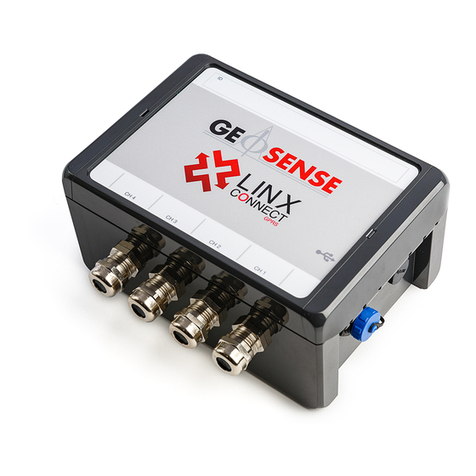
Geosense
Geosense Geologger Linx User manual

Geosense
Geosense HLC 6000 Series User manual
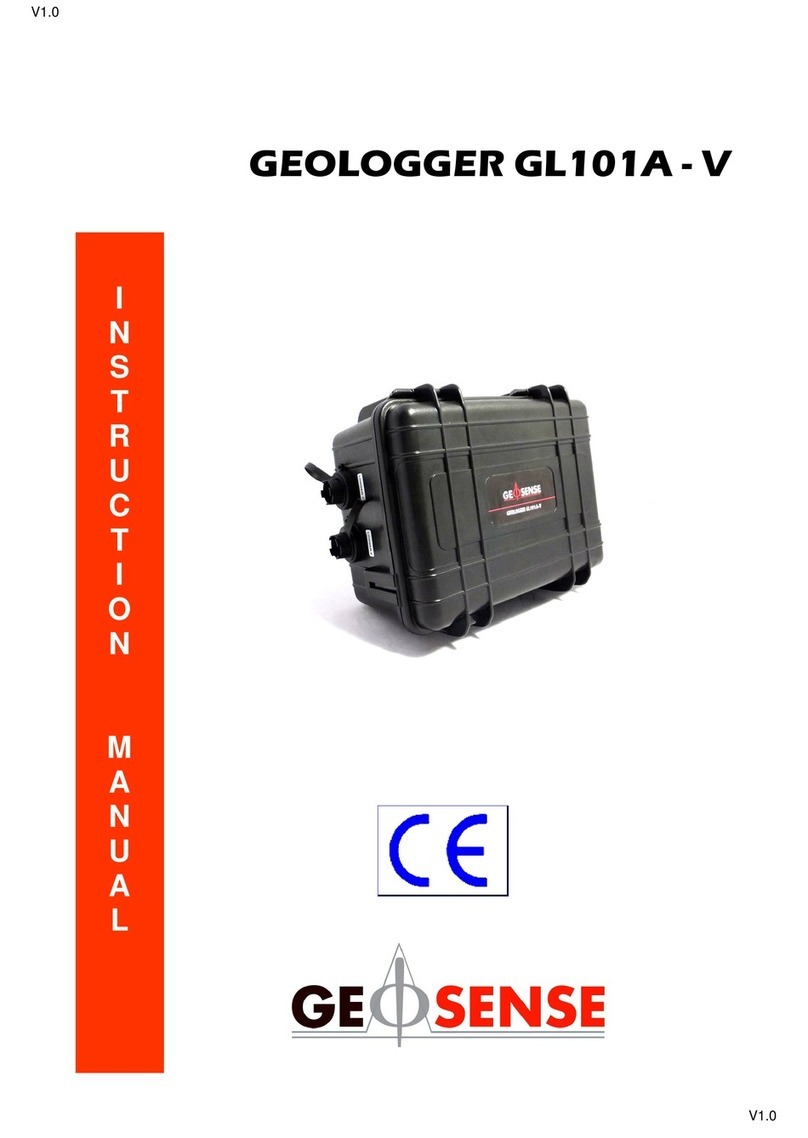
Geosense
Geosense Geologger GL101A-V User manual
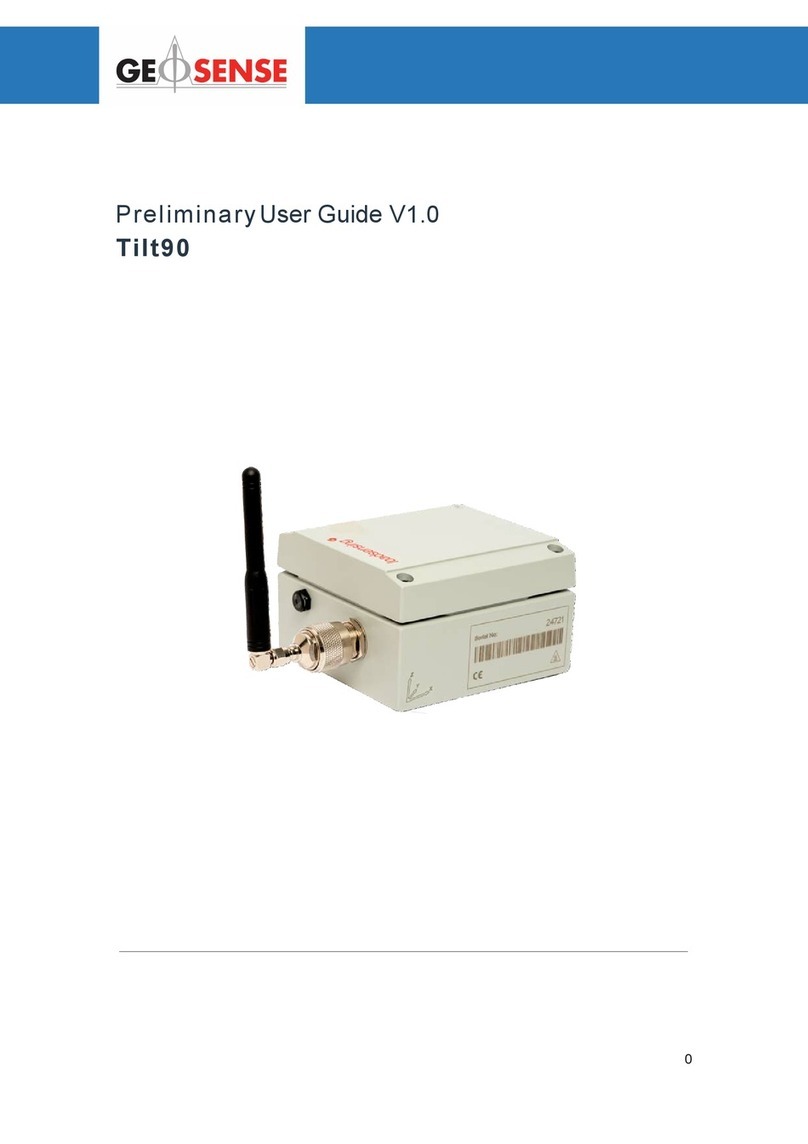
Geosense
Geosense Laser Tilt90 User manual
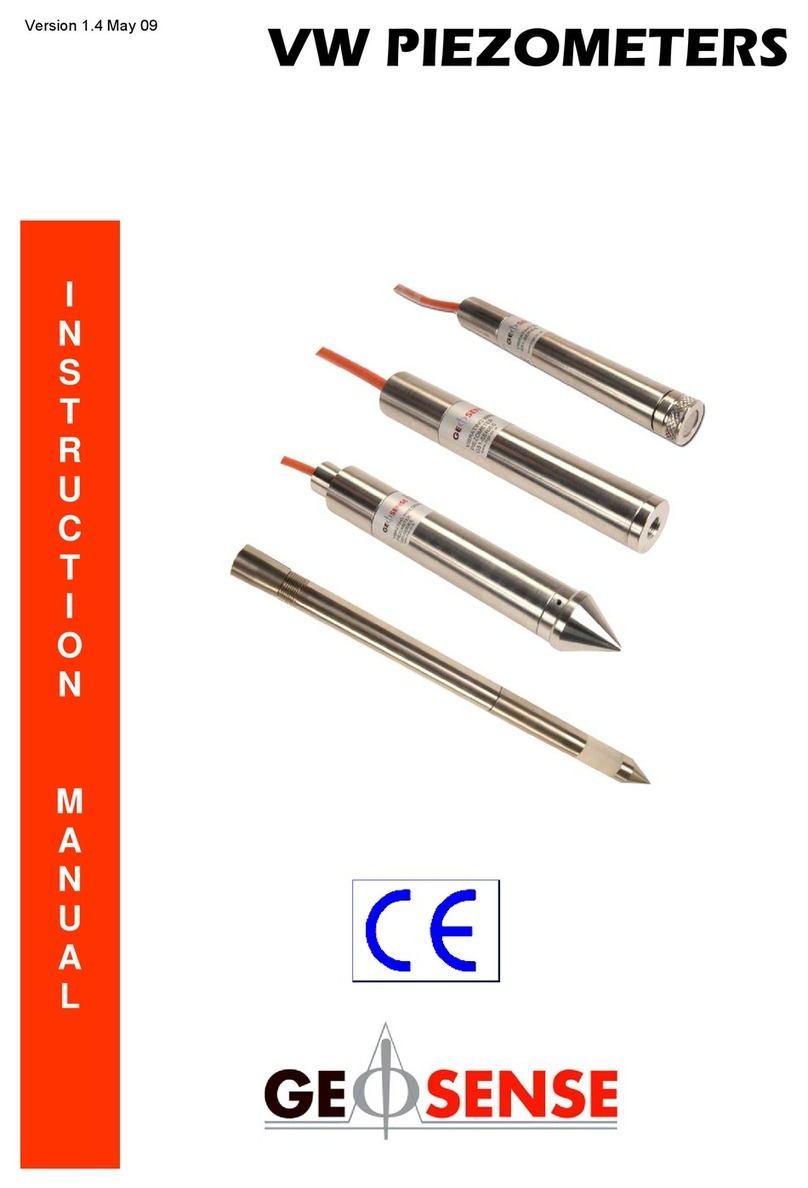
Geosense
Geosense VW PIEZOMETERS User manual

Geosense
Geosense Geologger Linx User manual
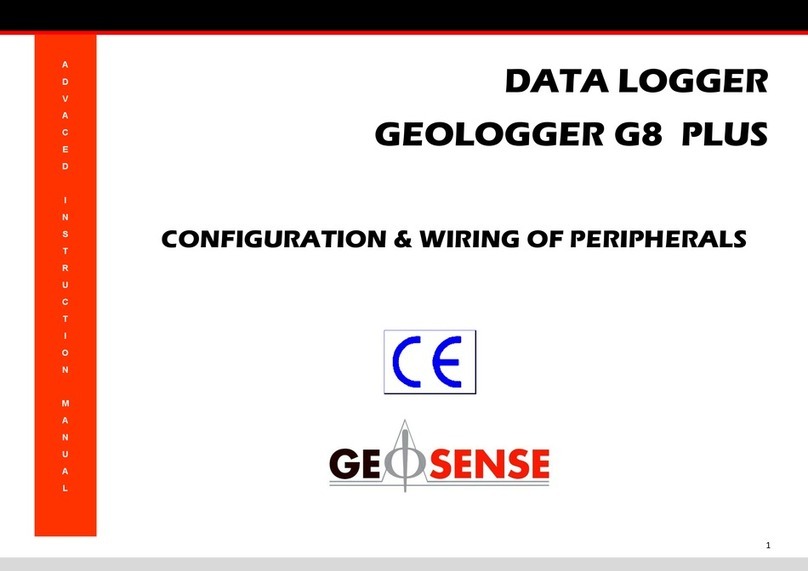
Geosense
Geosense GEOLOGGER G8 PLUS Setup guide
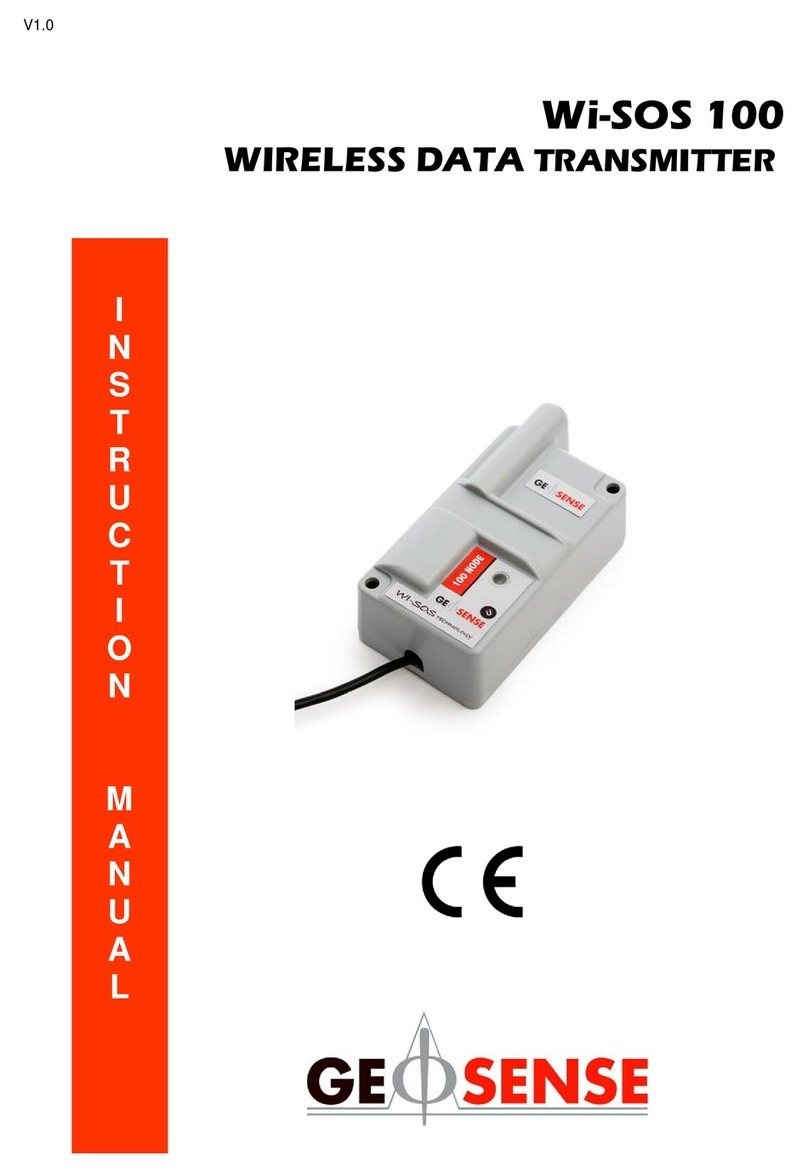
Geosense
Geosense Wi-SOS 100 User manual
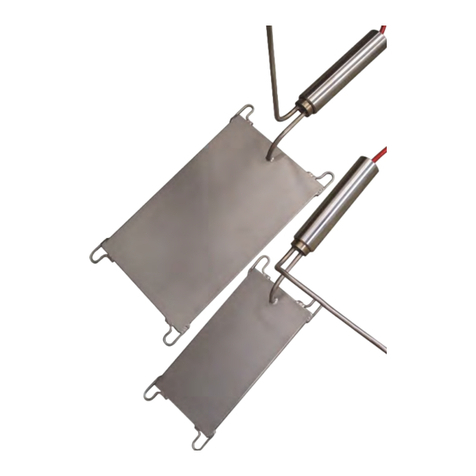
Geosense
Geosense VWNPC-3000 User manual

